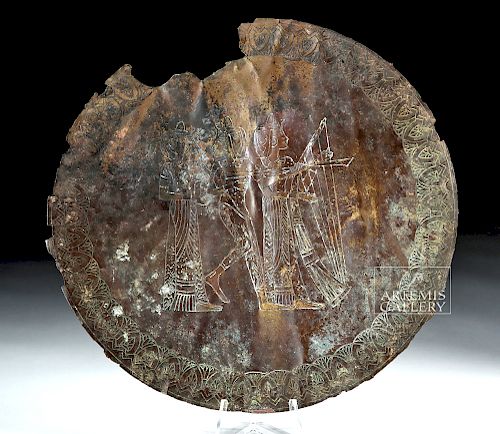Egyptian Bronze Mirror - Trio of Musicians
Lot 62a
About Seller
Artemis Fine Arts
686 S Taylor Ave, Ste 106
Louisville, CO 80027
United States
Selling antiquities, ancient and ethnographic art online since 1993, Artemis Gallery specializes in Classical Antiquities (Egyptian, Greek, Roman, Near Eastern), Asian, Pre-Columbian, African / Tribal / Oceanographic art. Our extensive inventory includes pottery, stone, metal, wood, glass and textil...Read more
Categories
Estimate:
$5,000 - $7,000
Absentee vs Live bid
Two ways to bid:
- Leave a max absentee bid and the platform will bid on your behalf up to your maximum bid during the live auction.
- Bid live during the auction and your bids will be submitted real-time to the auctioneer.
Bid Increments
| Price | Bid Increment |
|---|---|
| $0 | $25 |
| $300 | $50 |
| $1,000 | $100 |
| $2,000 | $250 |
| $5,000 | $500 |
| $10,000 | $1,000 |
| $20,000 | $2,500 |
| $50,000 | $5,000 |
| $100,000 | $10,000 |
| $200,000 | $20,000 |
About Auction
By Artemis Fine Arts
May 10, 2018
Set Reminder
2018-05-10 10:00:00
2018-05-10 10:00:00
America/New_York
Bidsquare
Bidsquare : Fine Ethnographic / Asian / Ancient Art
https://www.bidsquare.com/auctions/artemis-gallery/fine-ethnographic-asian-ancient-art-3213
Featuring antiquities from around the world including Pre-Columbian, Tribal, Classical, Asian, so much more! Artemis Fine Arts info@artemisfinearts.com
Featuring antiquities from around the world including Pre-Columbian, Tribal, Classical, Asian, so much more! Artemis Fine Arts info@artemisfinearts.com
- Lot Description
Egyptian or Egypto-Phoenician, ca. early 1st millennium BCE, ca. 9th to 7th century BCE. A special mirror of a thin, ellipsoidal form, made from hammered bronze and finely engraved with a three musicians surrounded by a decorative border of continuous abstract floral/foliage motifs. In its original condition, the bronze would have been polished enabling the ancient owner to see her/his reflection. Egyptian mirrors first appeared in the Old Kingdom (approximately 2613 to 2160 BCE) and the form which consisted of a polished disc of bronze or copper, attached to a handle, did not change very much over the course of history. In Egypt, the reflective surface was interpreted as the sun disc, because of its shape and illustrious qualities. Size: 6.75" W x 7" H (17.1 cm x 17.8 cm)
The engraving of this mirror presents three figures playing different instruments. Notice the harp-like instrument depicted in the composition. String instruments such as lyres, lutes, and harps were quite popular in ancient Egypt. As we see in this image, these were typically plucked rather than bowed. The central figure appears to be holding another instrument - either another string instrument with a long neck, or a horn. In addition to string instruments, wind and percussion instruments were enjoyed in ancient Egypt. The leftmost figure may depict a singer or a royal for whom the performance is intended.
Musicians held various positions in ancient Egyptian society. Temple musicians held the highest status, and musicians associated with the royal family also benefited from a elite social status. Given the elaborate costumes of the musicians depicted on this mirror, these figures more than likely were intended to represent musicians of such esteemed status. Just as it does today, music played a significant role in the lives of the people in ancient Egypt, as demonstrated by the many images and texts found on Egyptian monuments. Music was also an important component of religious rituals, and deities like Hathor and Bes were gods of music who were also linked with dance, childbirth, and fertility.
For related examples see Anlen, Leon, and Roger Padiou Les miroirs de bronze anciens. (1989) Guy Tredaniel, Paris, France. Dayagi-Mendels, Michal Perfumes and Cosmetics in the Ancient World. (1989) The Israel Museum, Jerusalem, Israel. Institut du monde Arabe, Paris, and Kunsthalle der Hypo-Kulturstiftung, Munich SOUDAN. Royaumes sur le Nil 1997 (Exhibition in Munich, Paris, Amsterdam, Toulouse, Mannheim.). Flammarion, Paris. (83, plate 89). Manniche, Lise Sacred Luxuries: Fragrance, Aromatherapy & Cosmetics in Ancient Egypt. (1999) Cornell University Press, Ithaca, NY.
Provenance: private East Coast, USA collection; ex-private Mazord collection, France, 1970's
All items legal to buy/sell under U.S. Statute covering cultural patrimony Code 2600, CHAPTER 14, and are guaranteed to be as described or your money back.
A Certificate of Authenticity will accompany all winning bids.
We ship worldwide and handle all shipping in-house for your convenience.
#133309Normal surface wear and bending commensurate with age. Imagery is still visible. Losses to peripheries as shown. Fissure to inner border at lower end of mirror. Charming patina has developed over the ages.Condition
- Shipping Info
-
All shipping is handled in-house for your convenience. Your invoice from Artemis Gallery will include shipping calculation instructions. If in doubt, please inquire BEFORE bidding for estimated shipping costs for individual items.
-
- Buyer's Premium



 EUR
EUR CAD
CAD AUD
AUD GBP
GBP MXN
MXN HKD
HKD CNY
CNY MYR
MYR SEK
SEK SGD
SGD CHF
CHF THB
THB
















